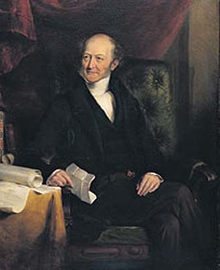Edward Smith-Stanley, 13th Earl of Derby
KG | |
|---|---|
 Portrait by William Derby, c. 1837 | |
| Born | 21 April 1775 Knowsley Hall, Lancashire |
| Died | 30 June 1851 (aged 76) |
| Spouse(s) |
Charlotte Margaret Hornby
(m. 1798; died 1817) |
| Issue | |
| Father | Edward Smith-Stanley, 12th Earl of Derby |
| Mother | Lady Elizabeth Hamilton |


Edward Smith-Stanley, 13th Earl of Derby (21 April 1775 – 30 June 1851), KG, of Knowsley Hall in Lancashire (styled Lord Stanley from 1776 to 1832, known as Baron Stanley of Bickerstaffe from 1832-4), was a politician, peer, landowner, builder, farmer, art collector and naturalist. He was the patron of the writer Edward Lear.
Origins
He was the eldest child and only son and heir of Edward Smith-Stanley, 12th Earl of Derby (1752–1834) by his wife Elizabeth Hamilton, a daughter of James Hamilton, 6th Duke of Hamilton.
Career
He was educated at
Military career
He was commissioned Colonel of the
Naturalist
In 1834 he succeeded his father as 13th
He founded in 1851 with his natural history's collection a museum in Liverpool, the Derby Museum, the current World Museum, the oldest of the National Museums Liverpool group.
Marriage and issue

On 30 June 1798 he married his first cousin Charlotte Margaret Hornby (d.1817), second daughter of Rev. Geoffrey Hornby (1750–1812), of Scale Hall, near
- Edward George Geoffrey Smith-Stanley, 14th Earl of Derby (1799–1869), thrice Prime Minister (1852, 1858–9, 1866–8)
- Lady Charlotte Elizabeth Smith-Stanley (1801–1853), married Edward Penrhyn
- Hon. Henry Thomas Smith-Stanley (1803–1875), MP for Preston (1832–7)
- Lady Emily Lucy Smith-Stanley (1804), died in infancy
- Lady Louisa Emily Stanley (1805–1825), married Lt.-Col. Samuel Long
- Lady Eleanor Mary Smith-Stanley (b. 1807)
- Colonel Hon. Charles James Fox Stanley (1808–1884)
Death
He died on 30 June 1851.
References
- ^ "Stanley, Lord Edward (Smith) (STNY792E)". A Cambridge Alumni Database. University of Cambridge.
- ^ "No. 13978". The London Gazette. 7 February 1797. p. 133.
- ^ "No. 13989". The London Gazette. 4 March 1797. p. 228.
- ^ a b Whalley, Joseph Lawson (1888). History of the old county regiment of the Royal Lancashire Militia. Simpkin, Marshall. pp. 145, 167.
- ^ "No. 15066". The London Gazette. 29 September 1798. p. 923.
- Richter, H. C.; Gould, John (1848). The birds of Australia. Vol. 5. London: Gould. pp. pl. 29 et seq.
- ^ State Library of NSW (19 June 2015). "TAL & Dai-ichi Life Derby collection of natural history watercolours, 1790s". Archived from the original on 29 March 2019.
- ^ Burke's Genealogical and Heraldic History of the Landed Gentry, 15th Edition, ed. Pirie-Gordon, H., London, 1937, p.1156
- ^ "Scale Hall, Lancaster, Lancashire".
- ^ Burke's Genealogical and Heraldic History of the Landed Gentry, 15th Edition, ed. Pirie-Gordon, H., London, 1937, p.1155, pedigree of "Hornby of Dalton Hall"
- ^ Escott, Margaret, biography of "Hornby, Edmund (1773-1857), of Dalton Hall, Westmld."
published in: History of Parliament: House of Commons 1820-1832, ed. D.R. Fisher, 2009 [1]
External links
- Hansard 1803–2005: contributions in Parliament by the Earl of Derby
- Stanley, Edward Smith, thirteenth earl of Derby (formerly Lord Stanley) (1775–1851), politician and naturalist by Clemency Thorne Fisher in Dictionary of National Biography
- "Archival material relating to Edward Smith-Stanley, 13th Earl of Derby". UK National Archives.
- The TAL & Dai-ichi Life Derby Collection at the State Library of New South Wales
